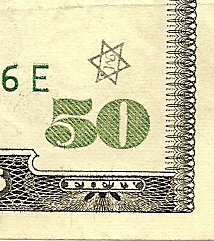
PREV ARTICLE
NEXT ARTICLE
FULL ISSUE
PREV FULL ISSUE
V11 2008 INDEX
E-SYLUM ARCHIVE
STAR STAMPS ON PAPER MONEY: MODERN CHOP MARKS
Last week I asked about a six-pointed star inkstamp I
noticed on a $50 bill. Not surprisingly, our readers have come forth with
an answer. -Editor
 Tom DeLorey writes
Tom DeLorey writes
Here at Harlan Berk's coin store in downtown Chicago, it
is not unusual to see $50 and $100 bills with small rubber stamps on them.
They are presumably bankers' and money exchangers' marks from overseas,
indicating that the bank or exchanger in question has examined the note
and found it to be genuine. It is the equivalent of the Chinese chop mark
on 19th century crown-sized coins such as Trade Dollars. We just ignore
them, and use our own observations of official counterfeit detection
devices on the bills to verify them. After all, any counterfeiter could
put any variety of "chop marks" on his bills to make it easier to pass
them.
Joe Boling writes:
The "M" in the star of David on the $50 note is a
money-changer's chop mark. Hundreds exist - so that the money-changer will
not have to examine the note closely the next time he receives it, to
determine its authenticity. Such marks are widely used in the mid-east,
somewhat less in the far east.
Wayne Homren, Editor
The Numismatic Bibliomania Society is a non-profit organization promoting numismatic literature. See our web site at coinbooks.org.
To submit items for publication in The E-Sylum, write to the Editor at this address: whomren@gmail.com
To subscribe go to: https://my.binhost.com/lists/listinfo/esylum
All Rights Reserved.
NBS Home Page
Contact the NBS webmaster
